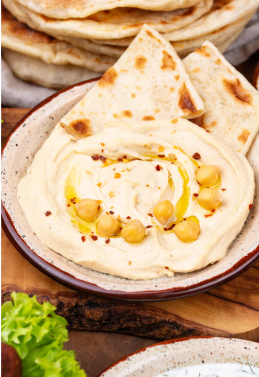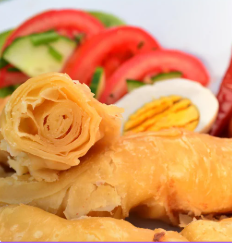This article is dedicated to Jewish/Israeli foods: some of the most famous, and some extremely underrated. I would like to start this amazing article with an entire category of culinary mastery: condiments and dips!!! Israeli cuisine has A LOT of flavorful condiments and dips. For example; instead of the NA staples of ketchup, mayo, and mustard, there is tahini, amba and schug. One of the most common dishes is hummus. Hummus is made of chickpeas which can be smoothe, with some chunks, or with different toppings. In Israel, hummus is often served with a Shabbat egg, a Jewish twist! I bet you are wondering, what is a Shabbat egg? A Shabbat egg is an egg, slow cooked overnight and eaten for Shabbat lunch. Although some people think hummus is a dip, in Israel you can find many Hummussiyot, a place where the entire menu is hummus! You choose which type of toppings like whole chickpeas, pinenuts, beef, and/or seasonings like paprika. There are even more options but so many I can’t explain!
At Hummussiyot you can also get other related dishes, such as masabacha (Mas-sa-ba-ch-a) and machlutah (ma-ch-lu-ta). Masabacha is a dip of hot chickpeas with tahini. machlutah (ma-ch-lu-ta) is made out of chickpeas, tahini, and fava beans (beans used commonly in Egyptian cuisine). When you eat hummus it feels smooth and creamy like eating a spoonful of less fluffy whipped cream. Hummus is usually served with some oil on top, hot chickpeas, and the occasional paprika/cumin chickpeas, tahini, and fava beans (beans used commonly in Egyptian cuisine). When you eat hummus it feels smooth and creamy like eating a spoonful of less fluffy whipped cream. Hummus is usually served with some oil on top, hot chickpeas, and the occasional paprika/cumin.

A somewhat similar sauce is tahini (in Hebrew t-ch-i-na). Tahini is a sauce eaten with many foods, such as falafel, shawarma, sabiech (which I will explain later) and more. Tahini is made of sesame seeds, with lemon, and garlic. Tahini is like eating a spoonful of smooth goodness. It is less thick than hummus and depending on how it is made it can be thicker or thinner than amba. Now, what is amba? Amba (a-am-ba) is a sauce made of fermented mango and fenugreek (chilbe), meaning this gooey sauce is salty meets sour in the middle. It is commonly eaten with shawarma and sabiech.
Now moving on to a spicy sauce: schug (s-ch-oo-g)! Schug is made of smushed spicy peppers, cilantro and like A LOT of Israeli foods, it has a cumin and salt added to the mix. It has a slight kick but many different tastes and if made correctly, balances each other out like the most beautiful dance in your mouth. It has a slight smooth texture which only compliments the spices more.
Now I would like to move on to the smoothest dishes of all, labneh (lab-a-neh). Labneh is pressed yogurt. It can be found in literally any Israeli restaurant and is served with za’atar (za-a-tar, a very common spice in Israel) and olive oil. It is served with pita and when you get this delightful appetizer/snack you are meant to take the pita and scoop the labneh with some olive oil and zaatar. When you put that perfect bite in your mouth you taste the smoothness of the labneh, the soft yet slight crunch of the pita and the zinginess of zaatar all in one bite of pure heaven.
This next dish is an appetizer, eaten most commonly on holidays such as; Rosh Hashanah and Pesach. I won’t keep you in suspense any longer. The dish is called cavved catzutz (cav-ved ca-tz-u-tz). Caved Catzutz is made of fried chicken liver, caramelized onions, and hard boiled eggs. This is commonly eaten with challah (or matza). The seasonings are pretty simple; salt and pepper. While the smell can fool you (as it did me for a long time) the taste is savory with a bit of sweetness from the onion and compliments the challah (or matza) kindly.
Next I would like to move on to one of the underrated classics (and this one is not a sauce/dip), can you guess what it is? Well it’s chulent (ch-u-lent, also known as chunt, ch-u-nt). This is more of a classic than you think, meaning Jews in Israel ate this dish before the diaspora, 2000 years ago! Chulent can be made many different ways; vegetarian, no eggs, extra potatoes, no beans and a BUNCH of other ways.
Fitting into the theme of overnight dishes is…jachnun (Ja-ch-nun)! Jachnun is a lot of thin layers of dough and butter that is blended together overnight. Jachnun is commonly eaten with shabbat eggs, grinded tomatoes, and schug. When eating this Jewish delight, you feel the slight sweetness of the jachnun, the softness of the egg, the spiciness of the schug, and the complimentary taste of the tomatoes. Jachnun can be found as street food, sold on the side of the road in Israel. Although more commonly it’s found in restaurants that sell other Israeli foods.
The next food up for cuisine’s got talent is another dish in the overnight club, kugel (ku-g-el). Kugel is made in very different ways based on preferences and traditions. Some families prefer sweeter or a more savory kugel. While sometimes families like to add some cinnamon or other similar spices. Believe it or not Kugel was born in the 16th century as a dish of leftover bread, egg, and fat. It evolved around 8 centuries ago to the Jewish-Polish lokshen (lock-sh-en) kugel we love and cherish. Kugel has been a Shabbat meal since the beginning, and contains; noodles, soft cheeses, eggs, sugar, and seasonings.
Finally, I would like to talk about my favourite food in the world, galaxy, universe! This food is the most underrated of all…sabich (sa-bee-ch)! Sabich is the most complex dance of flavors, weaving together into a masterpiece. All this happens in the softness of a pita. Sabich consists of shabbat eggs, amba, schug, hummus, tahini, Israeli salad, pickles, parsley, fried eggplant, along with occasional feta cheese, cauliflower, and potatoes. My family likes to often have Sabich nights, where we make all the different ingredients in separate plates that cover the table in beauty.

Kugel and jachnun are both found on the Shabbat hot plate in many Jewish homes. The Shabbat hot plate is a plate that connects to the electric outlet and is on a low heat all of Shabbat. This keeps all the foods on it warm and ready to eat. You’re allowed to take as much food off it but not allowed to put food back on the plate or put more food on it to warm it up.
Although we’ve been talking about many Jewish foods, where they are from, what they consist of and many other things, I think the most important part of Jewish food is being able to share it with family. The best part of food in general is that it brings people together.



